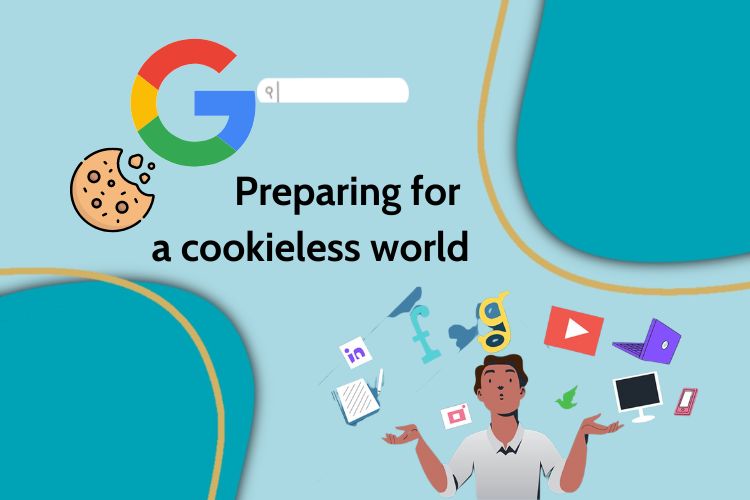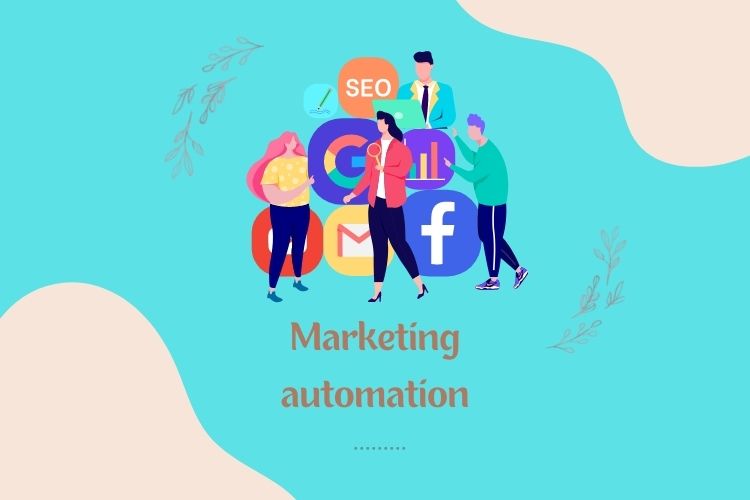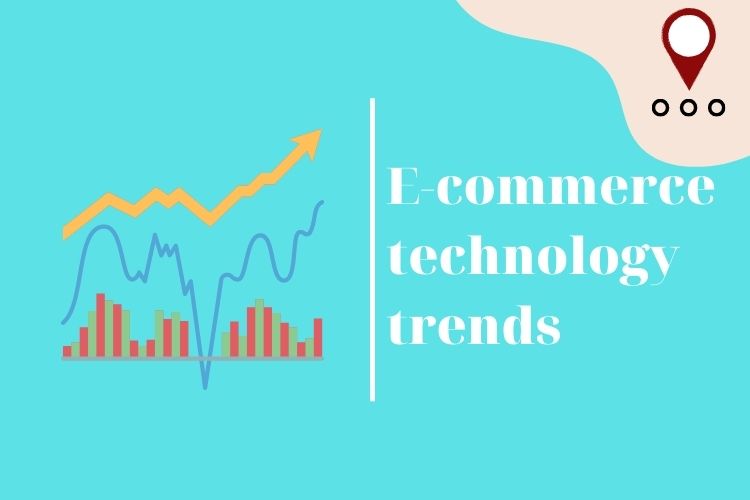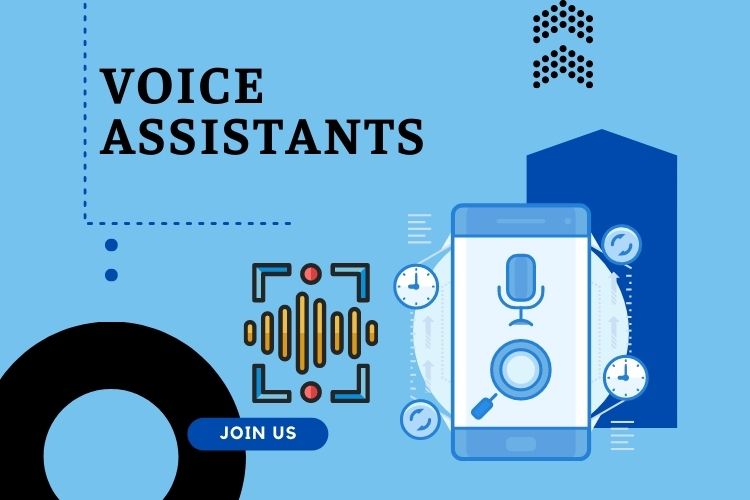E-commerce is a constantly evolving market; a slew of new eCommerce Technology trends emerge each year that may help your company develop and compete – and 2022 will be no exception. As the pandemic subsides, we may see eCommerce penetration decline compared to 2020. Nonetheless, several eCommerce enterprises have grasped the opportunity and forecast that 2022 would be the year of “eCommerce Technology” growth.
In this post, we’ll consider the bulk of the key trends in eCommerce technology that will influence the retail industry in 2022.
1. How technology is changing eCommerce
Nowadays, E-commerce has permeated many facets of our daily life. Consider how frequently you pull out your phone when you go shopping in a physical store to compare pricing, read product reviews, or take a picture of an item to share with family and friends for feedback.
1.1 Anywhere e-commerce: Making Every Moment Shoppable
Before technology raised customer expectations, all it took to convert internet customers was an add-to-cart button and a straightforward checkout process. Today’s consumers want to be able to shop anytime, anywhere, and with no friction. They also demand personalized, frictionless purchasing experiences.
Forrester estimates that 80% of consumers see no division in the digital world. It’s common to call this new normal “Anywhere Ecommerce.”
Success Anywhere to integrate and consolidate data, connect purchasing flows, and deliver tailored experiences across channels both online and offline. E-commerce needs a modern technology stack.
1.2 Preparing for a cookieless world

First-party and zero-party data will be more valuable than ever as brands work to overcome obstacles to the update of Apple’s iOS setting privacy, Facebook’s retargeting constraints, and Google’s plan to stop using third-party cookies.
Without relying on third-party data, technology that can easily (and securely) collect customer data, combine it, and transform it into actionable insights will help organizations plan their business campaign, refocus pivot marketing strategy, and predict shifting consumers’ behavior.
1.3 Highly competitive landscape
The entrance hurdle for eCommerce is quite low. It is using digital eCommerce platforms like Shopify. As a result, there is greater competition than ever in the online market. Brands may now compete with long-established household brand names that have dominated their industries for many years by having permission to access more tools at more reasonable price points.
2. What an ideal eCommerce technology stack looks like
We prepared a list of the eCommerce technologies we think are best based on client needs, market trends, and expert recommendations:
- Commerce platform
- E-commerce operating system
- Marketing automation
- Reviews and user-generated content
- SMS system
2.1. Commerce platform to sell, promote, and process online transactions

Through an online storefront, you may sell products, broadcast, and settle Payments thanks to your commerce platform. Modern e-commerce platforms, like Shopify or BigCommerce, have drag-and-drop shop builders that make it simple for you to personalize your storefront without coding. They can also manage inventory, orders, and refunds.
Numerous e-commerce platforms include widespread app stores with a variety of apps that let you customize how you run and expand your online business. These app stores also often have responsive designs that offer consistent user experiences across devices.
To manage orders across channels, you can often combine your commerce platform with social media platforms like Facebook, Instagram, and TikTok as well as online marketplaces.
2.2. E-commerce operating system
By gathering data from all of your sales and marketing channels—including direct-to-consumer (DTC), marketplaces, email, and social media, the eCommerce operating system eliminates access to this guesswork and laborious effort of managing their business Internet enterprises. It supplies the only smart system.
No more awaiting the days or even weeks-old observations from an analyst with a spreadsheet. Ecommerce operating systems leverage artificial intelligence (AI) instead of conventional analytics tools to automatically produce useful insights on ads, financial, inventory, and operational trends.
Applying an eCommerce operating system can assist you in overcoming the following frequent yet difficult business problems:
- Putting data manually into spreadsheets and uploading it
- Data silos that impede go-to-market and cause misalignment
- Obtaining insights from third-party data and creating predictive models
Having quick access to reliable, integrated data enables you to protect margins, boost operational effectiveness, make decisions more quickly, and spot revenue possibilities in an era of growing client acquisition costs.
Your eCommerce operating system integrates with your e-commerce platform, marketing tools, and sales channels. Supposing that you utilize Klaviyo for email marketing and have a DTC store built on Shopify in addition to selling goods on Amazon, Walmart, Facebook, and Instagram. Your e-commerce operating system is integrated with all of these channels.
Each function may easily collaborate to make business decisions that increase profit and enhance the customer experience by feeding data to a unified platform, which gives everyone access to the same data.
2.3. Marketing automation

Platforms for marketing automation use cutting-edge technology to create email lists and send targeted messages at the most advantageous points in the customer journey. Here are some strategies for using marketing automation to increase online sales:
- Segment customers automatically based on the products they browsed, how frequently they made purchases, the average order value, their region, or their level of loyalty.
- Email addresses and other client information (such as what product categories they are interested in) can be collected using mobile-first forms, and this information can then be used to customize the welcome email series.
- Send out emails to customers automatically with product reviews based on what they have seen on the website. QR codes can be used to collect customer information, send targeted marketing messages, and track the effectiveness of marketing campaigns
You may use artificial intelligence (AI) to A/B test and forecast a customer’s next move in the online purchasing process with a marketing platform like Klaviyo.
When you coordinate your marketing initiatives with your e-commerce platform, you can:
- Make sure you’re promoting goods that the business can deliver.
- Monitor the return on your marketing investments and alter your strategies to increase sales.
- Determine the net profit margin for each product, accounting for marketing expenses.
2.4. Reviews and user-generated content
To convert online buyers, user-generated content (UGC) repurposing and sharing are now essential. About 90% of consumers claim that UGC has a greater impact on their purchasing decisions than advertisements, emails, and search engines.
UGC and reviews enable customers to read frank comments from their peers about a product, see how it appears in real life, and make an informed choice. Even while some companies can be reluctant to disclose reviews, everyone benefits:
- You reduce the likelihood of returns by empowering customers to make knowledgeable purchasing decisions.
- You establish brand credibility: Consumers are 2.4 times more likely to claim that user-generated content is authentic than brand-created material, according to Hubspot.
- You receive knowledge about what consumers like and dislike about products, which you may use to plan inventories and guide the development of future products.
Yotpo and other UGC solutions make it simple to collect consumer reviews via email and reuse them in marketing campaigns, social media, and product pages. You can improve product discovery and engagement, lower cart abandonment, and overall customer satisfaction by adding customer photographs and review videos to the customer experience.
2.5. SMS tools
Using SMS solutions like Postscript or Omnisend, you may automatically send text message push notifications at strategic points in the customer journey. Does a consumer remove their shopping cart? Send a text message with a coupon code automatically.
By informing them of specials or new releases and granting them early access, SMS systems also aid in cultivating devoted clients. SMS technologies make it simple to manage and facilitate one-on-one customer discussions for a personalized purchasing experience for the most devoted customers.
III. Ecommerce technology trends to follow

3.1. Live Streaming is the inevitable eCommerce technology trend
Live streaming is the eCommerce technology trend that is the most well-known way. The footing used to illustrate a product and broadcast live across a platform, social network, or website is the same as live streaming eCommerce.
The rise of internet purchasing and consumers’ growing desire for human interaction are the main drivers behind the popularity of this method of multi-channel selling. In eCommerce, live streaming is a means to digital regeneration of the in-person buying experience.
Since visual appeal is crucial for online product sales, their companies frequently emphasize the value of product photography. Customers can get a closer look at the goods thanks to videos. Additionally, video allows customers to better understand a product and see it in operation.
Due to the drawback that selling objects cannot be handled, seeing someone else touch and describe things answers all of your questions.
A fantastic plugin called Facebook Livestream to stream Facebook Live videos right on their website. During the Livestream, your customers can forward linkage with your brand and make immediate purchases.
3.2 AI Technology in the eCommerce world
Personalized user experience
According to 74% of enterprises, user experience is critical for increasing sales and conversions. 59% of customers agree that a personalized user experience offered by AI affects their choice to make a purchase. A shopping experience backed by clients’ individual preferences can be facilitated by artificial intelligence.
Big data, machine learning, and artificial intelligence (AI) may provide analytics and foresight into consumer behavior patterns that can be used to drive marketing campaigns, deliver support and services, and automate communication – all of which enhance customer engagement rates for organizations.
Recommendations to customers
AI can provide appropriate and helpful information to clients on products and services as well as other topics since it can anticipate customer behavior patterns. By incorporating search history and other third-party data from a client, AI, and machine learning algorithms can predict this information with high accuracy. As a result, it may be possible to efficiently offer pertinent information and solutions to meet consumer needs.
The Cloud
A successful company that does not have at least one component of its business operations placed on the cloud will be difficult to discover. For everyone who wants fast access to data on any device, managing and processing data in the cloud is vital. A cloud ERP can increase delivery times, make your store more adaptive, and promote business stability and growth, especially for e-commerce companies.
3.3. Chat Bots

24/7 assistance
When a potential consumer searches for answers, many firms are unable to give them. Clients may also become irate while placed on hold because a company lacks the staff to respond to and serve a large number of customers.
Chatbots are accessible day and night, twenty-four hours a day, to provide any responses and solutions a potential consumer may need. Businesses can benefit from having this automated communication because it frees up personnel to concentrate on other business activities, effectively communicate with clients, and may even provide product and service suggestions.
Respond to queries
A decision tree is an algorithmic component of a chatbot. Decision trees, which essentially create, maintain, and constantly build upon a vast network of if/then statements, use machine and deep learning to automate complicated business operations.
Chatbots can enlarge their decision tree by answering frequently requested queries and consumer complaints. Here, a chatbot can learn whether or not they were able to assist a consumer. If they were able to assist the customer, they might share this knowledge with another customer who has a similar query. The chatbot may keep asking questions until it provides the customer the answers they need if they feel they have not fully satisfied them.
Send shipping and tracking information
Imagine if Amazon didn’t keep track of your address, credit card information, or the estimated delivery date for your item. Every time a consumer wants to make an online purchase from your store, they must submit their shipping information. Giving a consumer a timetable for when the order will arrive at their doorstep is also a top practice for user experience.
Chatbots can give clients real-time freight tracking information because they can recall this information. This can also benefit warehouse operations because they can stop worrying about informing consumers where their packages are and instead concentrate on the supply chain and completing orders using their order management system.
3.4. Voice Assistants

Audio brand signatures
An audio brand signature is any corporate jingle, musical composition, or aural tone. It enables companies to build stronger brand identities and aid the identification of the brand.
It is necessary to inform customers of the source of their purchases, businesses can instruct voice assistants to play their audio brand signature. Customers will recognize and remember they are placing an order from your store by associating your brand with an audio signature, even while they are sitting on their couch and speaking to a voice assistant.
Shopping lists
Instead of accessing a website (or store) every month to buy their necessities, customers would prefer to automate their ongoing purchasing requirements.
People can create shopping lists using voice assistants, ordering items from the vendors they want. With the help of this technology, numerous organizations can benefit from customer loyalty by learning about the preferences of the owners.
A voice assistant can match products on a customer’s shopping list if it is aware that they purchase them from your store regularly. Businesses may find this a useful way of anticipating sales and balancing order management.
Assistive technology
In the field of marketing, assistive technology, and voice commerce are supporting in reaching a wide range of new audiences, including the visually handicapped as well as the younger generation who are using new technologies.
The visually impaired can avoid the difficulties of a standard search experience. They can place orders by using speech-to-text technology.
AI, chatbots, and voice assistants are increasingly indispensable for any e-commerce company to succeed since they are all interrelated. Businesses must adopt these new technologies to maintain their suitability because they are more appealing to both present and potential clients.
3.5. Buy Now, Pay Later (BNPL)
One of the newest developments in eCommerce technology is the buy now, pay later service. It enables clients to pay for the goods in a series of interest-free payments.
During the pandemic, this kind of service became increasingly popular since consumers required flexible finance options. Customers opted not to use their credit cards when they made purchases, making BNPL an excellent choice.




Leave a Reply